During our trip to the Middle East Gulf States, our first stop was Abu Dhabi, UAE.
We didn’t have lots of things planned but there was one place that I was really hoping to visit, the Abu Dhabi Falcon Hospital.
After finding out that in the UAE, falcons get passports, I really wanted to check out the hospital even though a reader commented that they were disappointed after their visit.
During (and after) our tour I sure was glad that I went with my gut and took the tour!
Falconry is a big sport in the Emirates (and other countries in the Gulf) but it also has a history in the country as a way that the nomadic people used to hunt. These days, falcons can not be caught in the wild and must be bought, usually costing a lot of money.
At the beginning of the tour we learned a little about the three kinds of falcons- peregrine, saker and gyrfalcon. We also learned how the falcons are trained, staying on the owner’s arm for long periods of time, even eating with and being treated like a member of the family. 80% of the birds used by falconers are female since they are stronger than males.
After moving on from the small exhibit area, we were led into what I’d best describe as the exam area, also where minor procedures are performed.
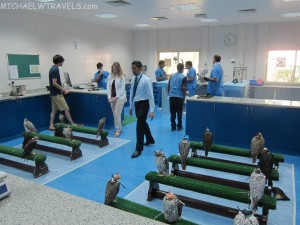 As we walked in the room, our group was amazed by all of the patients waiting for their turn. Just about all of the falcons were very calm while waiting. They wear a hood which covers their eyes which helps with this.
As we walked in the room, our group was amazed by all of the patients waiting for their turn. Just about all of the falcons were very calm while waiting. They wear a hood which covers their eyes which helps with this.
I almost forgot to mention our chance to check out the falcon passport. Falcons each get their own passport so they can fly on planes. We were told, there are times you can get on a flight and see people sitting with a falcon on their arm. Could you imagine seeing this?!
The passport has a unique ID number which matches a chip implanted into the falcon for identification. Other important details about the bird are also listed. They also get stamps each time they enter and leave a country.
Back to the check-up/ surgery area:
We then got to see a couple of minor procedures done on one of the falcons.
First she was put under to keep still while the operation was done. The anesthesia took effect pretty fast and the bird was out.
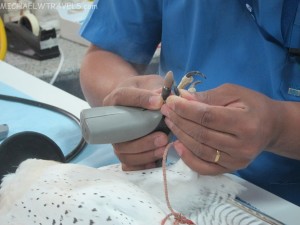
Then the vet clipped the talons a bit shorter with what looked like wire cutters. After he was done, the talons were smoothed a bit with a small handheld sanding machine.
When this was done, he then had to file down the beak. Since a falcon’s beak is curved, it can grow too long and continue inwards which can hurt the bird. A similar process used to trim down the talons was done to the beak.
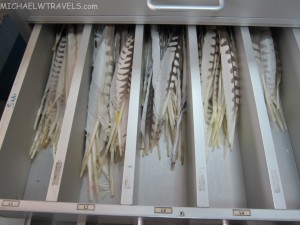
We were also showed some of the supplies used at the hospital. Wire cutters, nail clippers, sanders, even old feathers which fell out during molting (when the feathers fall out and change.)
Old feathers are saved to use if good ones break off. They demonstrated how a feather can be repaired which was pretty interesting.
Then the highlight of our visit took place. We got to hold a falcon. (I got to hold 2!)
While waiting to hold the larger falcon, they brought out a cute, little falcon for Lucas to hold. I thought he’d be hesitant or refuse to participate. However, like a true champ, he put on the glove and held the little falcon, petting it so gently!
While waiting to hold the larger falcon, I was offered a chance to hold the little guy, which I did without a glove. Fun stuff!
I then had a couple of minutes to hold the larger falcon. There was a big difference in weight between the birds.
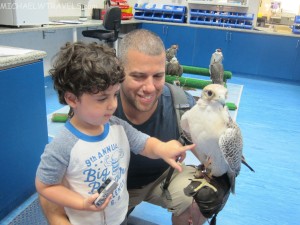
Since Lucas couldn’t hold this falcon, I let him at least pet this one, too.
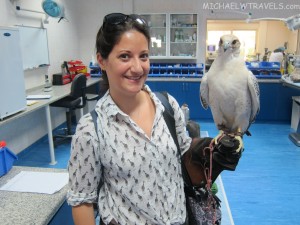
I think Kim was more scared than Lucas to hold the falcon! 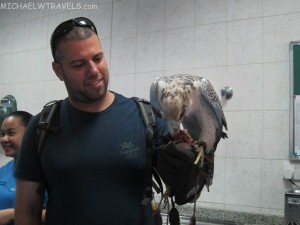 After our group all had a chance to hold a falcon, they asked for a volunteer to help feed one. I raised my hand immediately and got the chance.
After our group all had a chance to hold a falcon, they asked for a volunteer to help feed one. I raised my hand immediately and got the chance.
I was given a chunk of chicken to hold in my gloved hand. It was weird hearing the ripping sounds as the falcon had her lunch.
When the feeding was done, we were shown the surgery rooms for more serious procedures and the area where people can pay a fee to leave their falcons while they are going through molting (changing their feathers). The birds are kept in air-conditioned facilities and receive very good care.
The tour ended at another museum which has displays of animals native to the UAE. Nothing too exciting but a decent place to end the visit.
If you happen to be visiting Abu Dhabi, I’d highly recommend a visit to the Falcon Hospital. I’d consider it a unique attraction which both adults and children are most likely to enjoy.
The Abu Dhabi Falcon Hospital is located minutes from the airport. We took a standard tour at 10:00 AM which was 2 hours long and cost 170 AED, around $46 US. (Tours are also offered a 2:00 PM).
Find out more about the Abu Dhabi Falcon Hospital here.
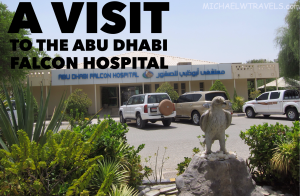
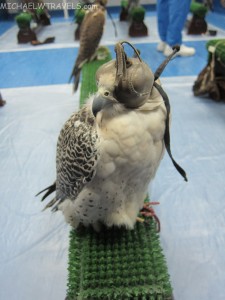
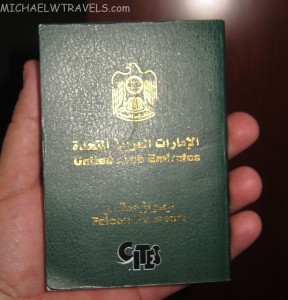
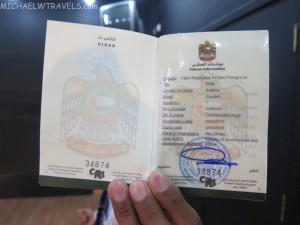
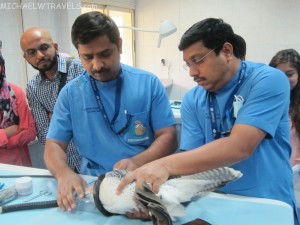
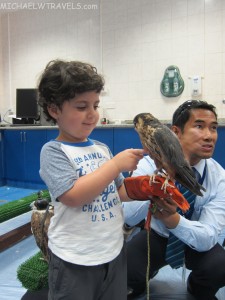
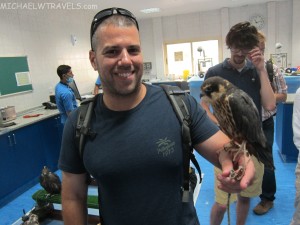
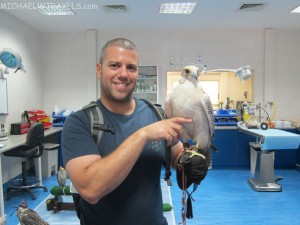
Nuzhath- Thank you and glad you enjoyed!
This is a special post about Falcon Hospital in Abu Dhabi. Its world’s first falcon welfare hospital and has been contrlloed by Dr Margit Gabriele Müller.